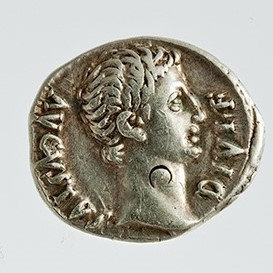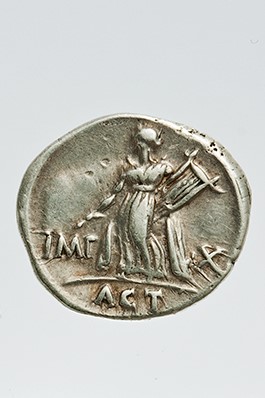Title: Denarius of Augustus - 2006.04
Acquisition number: 2006.04
Author or editor: Beryl Rawson
Culture or period: Roman Imperial
Date: 15-13 BC
Material: Metal - Silver
Object type: Coins - Roman
Dimensions: 20mm (w)
Origin region or location: France
Origin city: Lugdunum
Display case or on loan: 5
Keywords: Coin, denarius, Roman, Imperial, Augustus, Apollo, Gaul, Lugdunum, Roman Gaul
Sear, D.R., Roman Coins and their Values 5 vols (London, Spink, 2000-2014) 1611; Mattingly, H., E.A. Sydenham, C.H. Sutherland, R.A. Carson, The Roman Imperial Coinage 13 vols (London, Spink, 1923-1994) 171a; Mattingly, H.,Coins of the Roman Empire in the British Museum, 6 vols (London, 1965) 461 (=Grueber, H.A., Coins of the Roman Republic in the British Museum 3 vols (London, The Trustees of the British Museum, 1910; rev. edn London, 1970) Gaul 175); Giard, J.-P., Catalogue des Monnaies de l’Empire Romain 3 vols (Paris: Bibliothèque Nationale, 1988-1998) 1396; Seaby, H.A., Roman Silver Coins (London, B.A. Seaby, 1967) 144, (Lugdunum, 15-13 BC); Sutherland, C.H.V. and R.A.G. Carson, The Roman Imperial Coinage vol. 6: From Diocletian’s Reform (AD 294) to the death of Maximinus (AD 313) (London, Spink, 1967) I2 52 no. 171a and plate 3.
2006.04
Denarius of Augustus
3.79 g. 15-13 BC Lugdunum
Obv.: Head of Augustus, bare, r. AVGVSTVS DIVI F(ilius).
Rev.: Apollo (citharoedos) standing l. in full drapery, plectrum in r. hand, lyre in left. IMP. X to l. and r. of Apollo. ACT(ium) in exergue.
The coin celebrates Apollo’s role in Octavian’s victory at Actium on 2 September 31 BC against Antony and Cleopatra. Apollo is represented here as a lyre-player (citharoedos) as music was one of his chief attributes, but he was also seen as a civilising, peace-bringing god. Octavian vowed a new temple for Apollo in 31 BC, and began its building in 28 BC on the Palatine in Rome, next to his own residence. The temple was known as the Apollo Palatinos. He received the title ‘Augustus’ in 27 BC, and had advertised himself as the son of the deified Julius Caesar (DIVI F.) soon after his alleged ‘adoption’ was regularised, in 43 BC.
From 16 BC Roman coinage focuses mainly on Augustus. This reverse is one of the two dominant ones; the other is the butting bull (see 68.04). From 15 BC Lugdunum is the sole mint for gold and silver. The numbers of Augustus’ acclamations help specify dates: thus IMP X covers 15-13 BC, IMP XI begins at 12 BC. Augustus visited Lugdunum frequently: for example, in 16, 10 and 8 BC.
Sear, D.R., Roman Coins and their Values 5 vols (London, Spink, 2000-2014) 1611; Mattingly, H., E.A. Sydenham, C.H. Sutherland, R.A. Carson, The Roman Imperial Coinage 13 vols (London, Spink, 1923-1994) 171a; Mattingly, H.,Coins of the Roman Empire in the British Museum, 6 vols (London, 1965) 461 (=Grueber, H.A., Coins of the Roman Republic in the British Museum 3 vols (London, The Trustees of the British Museum, 1910; rev. edn London, 1970) Gaul 175); Giard, J.-P., Catalogue des Monnaies de l’Empire Romain 3 vols (Paris: Bibliothèque Nationale, 1988-1998) 1396; Seaby, H.A., Roman Silver Coins (London, B.A. Seaby, 1967) 144, (Lugdunum, 15-13 BC); Sutherland, C.H.V. and R.A.G. Carson, The Roman Imperial Coinage vol. 6: From Diocletian’s Reform (AD 294) to the death of Maximinus (AD 313) (London, Spink, 1967) I2 52 no. 171a and plate 3.

